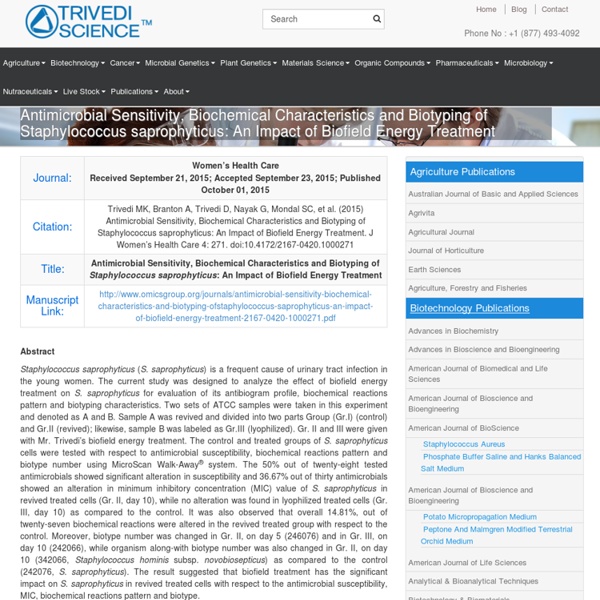Biotyping of Enteropathogenic MDR Escherichia coli Isolates
Description Study background: Multidrug resistant Escherichia coli (MDR E. coli) has become a major health concern, and failure of treatment leads to huge health burden. Aim of the present study was to determine the impact of Mr.
Multidrug Resistant Isolates of Pseudomonas Aeruginosa
Abstract In recent years, prevalence of multidrug resistance (MDR) in Pseudomonas aeruginosa (P. aeruginosa) has been noticed with high morbidity and mortality. Aim of the present study was to determine the impact of Mr.
Potential Impact of Biofield on HIV Viral Load Test
Abstract Viral load quantification is the amount of particular viral DNA or RNA in a blood samples. It is one of the surrogate biomarker of AIDS. High viral load indicates that the immune system is failed to fight against viruses. The aim of this study was to evaluate the impact of biofield treatment on HIV-1 and HCMV in terms of viral loads as surrogate marker.
Research on Escherichia Coli Biochemical Characteristics
Bioeld as an energy medicine has been included in complementary and alternative medicine (CAM) therapies, and very commonly practiced in US by professional healthcare representative [11]. CAM therapies are very helpful to improve the human wellbeing and health without having any side eects.
Study of Antimicrobial susceptibility of S. Marcescens
Abstract Serratia marcescens (S. marcescens) is Gram-negative bacterium, associated with hospital-acquired infections (HAIs), especially urinary tract and wound infections. The present study was aimed to evaluate the impact of biofield treatment on phenotyping and genotyping characteristics such as antimicrobial susceptibility, biochemical reactions, biotype, DNA polymorphism, and phylogenetic relationship of S. marcescens (ATCC 13880). The lyophilized cells of S. marcescens were divided into three groups (G1, G2, and G3). Control group (G1) and treated groups (G2 and G3) of S. marcescens cells assessed with respect to antimicrobial susceptibility, and biochemical reactions.
Analysis of Multidrug Resistant S.Maltophilia
Abstract Stenotrophomonas maltophilia ( S. maltophilia ) is a Gram-negative bacillus, an opportunistic pathogen, particularly among nosocomial infections. Multi-drug resistant strains are associated with very high rate of morbidity and mortality in severely immunocompromised patients. Present study was designed to evaluate the effect of biofield treatment against multidrug resistant S. maltophilia . Clinical sample of S. maltophilia was collected and divided into two groups i.e. control and biofield treated which were analyzed after 10 days with respect to control. The following parameters viz. susceptibility pattern, minimum inhibitory concentration (MIC), biochemical studies and biotype number of both control and treated samples were measured by MicroScan Walk-Away® system.
Experimental results of Escherichia Coli Antibiotic Sensitivity Assay
Study background: Multidrug resistant Escherichia coli (MDR E. coli) has become a major health concern, and failure of treatment leads to huge health burden. Aim of the present study was to determine the impact of Mr. Trivedi’s biofield treatment on E. coli. Methods: Four MDR clinical lab isolates (LSs) of E. coli (LS 8, LS 9, LS 10, and LS 11) were taken and divided into two groups i.e. control and biofield treated.
Genotyping Characterization of Staphylococcus Aureus
Abstract Staphylococcus aureus (S. aureus) is the key organism for food poisoning due to massive production of heat stable exotoxins. The current study was attempted to investigate the effect of Mr. Trivedi’s biofield treatment on S. aureus.
Evaluation of Phenotype and Genotype of Enterobacter Aerogenes
Abstract Enterobacter aerogenes (E. aerogenes) has been commonly described as a versatile opportunistic pathogen in hospital infections. The aim of the present work was to evaluate the impact of biofield treatment on E. aerogenes for its phenotypic and genotypic characteristics. E. aerogenes bearing ATCC 13048 (American Type Culture Collection) was procured from Bangalore Genei, in sealed pack and divided into control and treated groups. Treated group was subjected to Mr.



